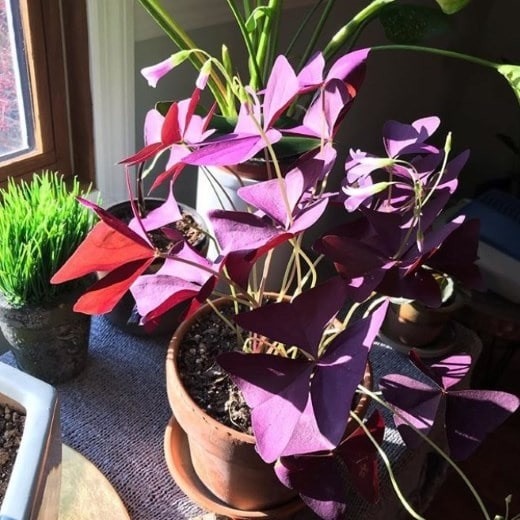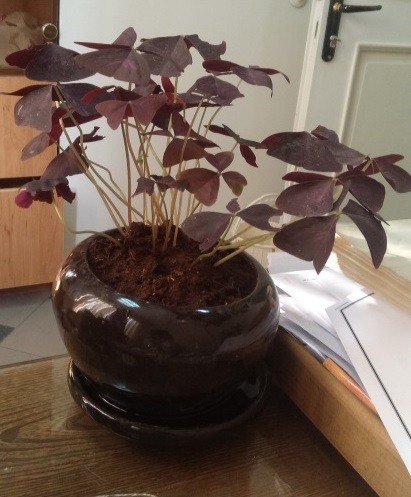Oxalis triangularis (false shamrock plant) is a bulb-type flowering plant grown as either a houseplant or part of your garden landscape. Thanks to its vibrant and eye-catching purple foliages that make a lasting impression.
Oxalis triangularis care involves the provision of well-draining potting soil, regular watering, moderate humidity, bright indirect sunlight, and feeding every two to three weeks of the growing season. Keep the indoor temperature about 60-70oF.
Continue reading this false shamrock plant care guide to discover some of the hidden problems for growing the plant indoors and their respective solutions. Besides that, you will learn more about oxalis triangularis benefits to humans.
You Can Also Read: How to Care for Philodendron Birkin

What Does Oxalis Triangularis Look Like?
Oxalis triangularis is also called a false shamrock plant since it is commercially marketed as clover or true shamrock native to Ireland.
The houseplant has small pinkish or white-colored blooms that match the rich purple leaves to make a bold statement. The purple shamrock has three petals that look similar to clovers.
The purple shamrock belongs to a wood sorrel family and is native to Brazil. The species can adapt to indoor growing conditions, unlike the true shamrock.
These perennial plants go through a dormancy period once a year during winter. Oxalis triangularis plants are safe for human consumption and not pets.
A mature false shamrock has a maximum height of 10 to 12 inches. The height makes this perennial plant ideal as a groundcover in areas with 60-75oF temperature range.
Oxalis Triangularis Care Details
| Origin | Brazil |
| Scientific Name | Oxalis triangularis |
| Common Names | Purple shamrock False shamrock Wood sorrel |
| Maximum Growth | 10-12 inches tall |
| Temperature Range | 60-75oF (15-24oC) |
| Watering Needs | Moderate soil moisture |
| Light Requirements | Bright indirect sunlight |
| Soil Requirement | Light and well-draining |
| Fertilizer Application | Water-soluble fertilizer every 2-3 weeks during growing season |
| Humidity Level | Average room humidity of 40% |
| Re-potting | Once every two to three years |
| Propagation | Bulb cutting |
| Pruning Requirement | Low to none |
| Pests and Diseases | Pests: Spider mites and mealybugs Diseases: Rust and Powdery mildew |
| Toxicity | Poisonous to cats and dogs |
How to Care for Oxalis Triangularis Plant
Oxalis Triangularis Soil Mix
Oxalis triangularis thrives in light and well-draining potting soil. The bulbs tend to rot if grown in a heavy and compact potting mix.
I recommend the use of rich and lightweight potting soil with or without slow-release fertilizer. But the addition of organic fertilizer helps to improve soil fertility and foster vegetative growth.
Consider a mixture of an equal amount of potting soil and peat. The potting mix can drain and hold moisture to enhance better growth. Keep in mind purple shamrock is vulnerable to bulb rot.
Best Oxalis Triangularis Pot
Purple shamrock thrives in potting soil with moderate moisture. A damp environment increases the risk of bulb rot in oxalis triangularis.
Use a container with drainage holes at the bottom (Check the Best Deals on Amazon) to help get rid of excess water. These drainage holes also help to prevent soggy soil formation.
Oxalis Triangularis Light Requirements
Place your false shamrock indoor in a location that receives bright indirect sunlight. The low light condition makes the perennial plant leggy and less robust.
Too much direct sunlight will make the purple shamrock wilt and die. I recommend placing the plant outdoor early in the morning. The sun’s intensity won’t harm your houseplant.
Ensure the window has curtains or shears to reduce the sunlight intensity. The filtered natural light enables the plant to flourish.
How to Water Oxalis Triangularis
Oxalis triangularis is a forgiving perennial plant that can survive without water for short periods than other oxalis species. Soggy soil conditions can lead to bulb rot problems.
Water the purple shamrock more often in spring and summer. The plant uses more water to facilitate active growth and vegetation.
Reduce the frequency of watering in winter and fall due to the dormancy phase. It is the period where this plant stops growing. I recommend watering the plant after every two to three weeks.
The golden rule is to inspect the soil moisture content before watering. Insert your index finger in the topsoil and feel the moisture level.
Oxalis Triangularis Humidity Requirement
Purple shamrock can survive in any indoor humidity since it is not fussy like other houseplants. It can tolerate average humidity inside the house by being healthy and happy.
But low humidity makes the plant foliages turn brown along the edges and tips. I recommend installing a humidifier to help boost the indoor humidity level.
Best Temperature Range for Oxalis Triangularis
Indoor purple shamrock loves a temperature range of 60-75oF (15-21oC). The temperature condition enhances plant vegetative growth and happiness.
Hot drafts can make the foliages wilt and fall off. I recommend keeping the houseplant away from heat drafts during winter due to the use of artificial heating devices.
How to Fertilize Oxalis Triangularis
The false shamrock is not a heavy feeder like other perennial plants. But the fertilizer provides nutrients that enhance active growth in summer and spring.
Do not feed the houseplant in winter and fall due to dormancy. It is the period where the plant stops growing and utilizing the nutrients from the soil.
Feed the purple shamrock every four weeks during the growing season. Use water-soluble fertilizer to feed your houseplant.
Over-fertilization can result in the burning of leaves and the soil will require regular flushing. It is the best method of getting rid of excess salt around the plant bulb.
Oxalis Triangularis Dormancy
Winter and fall are the seasons where purple shamrock enters dormancy. The plant foliages begin to turn brown and dry. The period allows the plant to rest and recharge or rejuvenate.
Dormancy tends to be unpredictable when growing oxalis triangularis indoors. It can be triggered by higher temperatures of 80oF (27oC) and above.
I recommend pruning the brown foliages and reducing the watering frequency. Move the plant to a cool and dark location for two-four weeks to enhance maximum rest.
Return the houseplant to a bright location and commence a regular watering routine. Feed the plant to stimulate new growth and allow it to rejuvenate.
Pruning and Maintenance
The pruning requirement for purple shamrock is low to none. Consider snipping off dead or old foliages from the plant during dormancy phase.
How to Repot Oxalis Triangularis
Oxalis triangularis plants are less vulnerable to root-bound issues. But repotting is commendable when the potting soil is exhausted after two to three years.
Use a larger container in case you are not separating the bulb offsets when transplanting the houseplant. Winter and fall is the best time to repot purple shamrock due to dormancy.
Oxalis Triangularis Propagation
Separation of bulb offsets to create additional plants is the best method for propagating purple shamrock. The process should be undertaken when the plant is experiencing a dormancy period.
Remove the false shamrock from the container and gently pull the bulb apart. Plant each part in a new container with fresh potting soil.
Allow the foliages to die completely before propagating the bulb. Separating the bulbs with active leaves will result in growth disruption of the parent plant.
Common Problems and Solutions
Pests
Purple shamrock plants are less susceptible to insect infestations. But this does not imply that the houseplant is invincible to pests.
Spider mites and mealybugs usually attack the underside of the purple shamrock foliages. Take the time to investigate your plant for confirmation.
I recommend the use of insecticidal soap spray to eliminate the pests. Consider spraying the houseplant every week until all the insects are eradicated.
Diseases
The false shamrock is free from serious disease problems. But overwatering the plant could result in bulb rot due to the damp environment.
The rot makes the bulb turn black and mushy leading to plant death. I recommend discarding the plant and starting with a fresh one. Schedule a strict watering routine to avoid overwatering.
Other possible diseases affecting purple shamrock are powdery mildew and rust. These conditions show up due to improper false shamrock care regime.
Frequently Asked Questions
Is Oxalis Triangularis Toxic to Humans and Pets?
The leaves of purple shamrock have a bitter taste and are non-toxic to humans. But the oxalic acid in the foliages can be toxic to cats and dogs.
Always keep your houseplant away from pets and toddlers to avoid destruction. The rule helps houseplant enthusiasts to manage their indoor plant collections.
Why Are My Purple Shamrock Leaves Turning Yellow?
Overwatering is the leading cause of purple shamrock leaves turning yellow. The damp environment inhibits bulb roots aeration and results in root rot issues.
Water the houseplant more often in summer and spring due to active growth. Remember to reduce the watering frequency in fall and winter due to the dormancy phase.
Use a pot with drainage holes and a well-draining potting mix to prevent overwatering problems from happening. Inspect soil moisture before watering the houseplant.
Why Does My Purple Shamrock Leaves Have White Spots?
Powdery mildew and rust are responsible for white spots on purple shamrock leaves. The problem occurs when the plant is placed in a cool and darkroom for an extended period.
Change the current location of the plant to a bright and warm environment. Reduce the humidity level and spray the plant with fungicides.
Do Purple Shamrock Leaves Close at Night?
Yes. The leaves of purple shamrock do close at night and reopen during the daytime hours. It is common among the Oxalis varieties.
Why is My Oxalis Triangularis Drooping?
Inconsistent watering routine results in purple shamrock dehydration to cause drooping to conserve the remaining water. Another possible cause is high temperatures and direct sunlight exposure.
You May Also Like: How to Care for Calathea Warscewiczii

Final Word on False Shamrock Care
The oxalis triangularis (purple shamrock) is a fantastic houseplant and groundcover on the garden landscape. The stunning and eye-catching purple foliages make a lasting impression.
The proper indoor growing condition makes this plant experience robust growth and coloration throughout the year. It is the best houseplant for beginners to give it a try.
How to care for purple shamrock involves the provision of bright indirect sunlight, average humidity, and light and well-draining soil mixtures. Feeding every three weeks during the growing season is recommendable.
